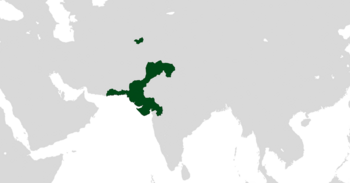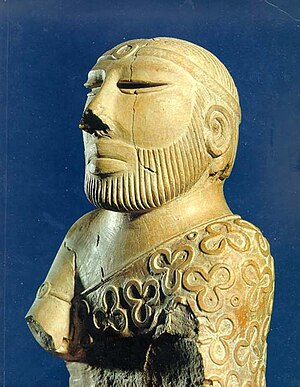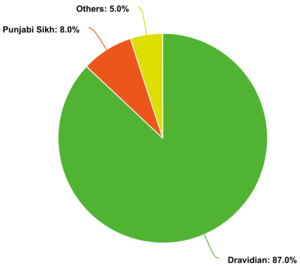Mel-akkam
Cooperative State of Mel-akkam Sahakara Mel Akam | |
|---|---|
|
Flag | |
| Motto: Santi mariyu purogati | |
| Anthem: Pata Pasupati | |
 Location of Mel-akkam (dark green) | |
| Capital and largest city | Mohenjo-daro |
| Official languages | Dravidian |
| Recognised national languages | Punjabi Hindi English |
| Ethnic groups |
|
| Demonym(s) | Mel-akkan |
| Government | Unitary assembly-independent republic |
| Pujari Adhineta | |
| N'yt'yam N'ymaina | |
| Nirtyam Am'mayi | |
| Legislature | Commissions Coordinating Council |
| History | |
• Mehrgarh Established | ~7000 BCE |
• Organised by Pujari Nayaku | ~2600 BCE |
• Independence | 1947 |
| Area | |
• Total | 800,000 km2 (310,000 sq mi) |
| Population | |
• 2023 estimate | 509,120,056 |
• 2020 census | 473,621,972 |
| GDP (nominal) | 2020 estimate |
• Total | $8.18 trillion |
• Per capita | $16,066 |
| HDI | 0.848 very high |
| Currency | Bangle (bng) (BNG) |
| Date format | dd-mm-yy |
| Driving side | left |
| Internet TLD | .ml |
Mel-akkam, officially the Cooperative State of Mel-akkam (Dravidian; Sahakara Mel Akam), is a nation located in South Asia. It is a unitary assembly-independent republic; its capital and largest city is Mohenjo-daro.
Etymology
"Mel Akam" means literally "high country" or "highlands", referring to the Balochi mountains where the Mel-akkan people were believed to have originated. The Sumerians transliterated "Mel Akam" as "Meluhha", while the Vedic Indo-Aryans of the Oxus Civilisation referred to the Mel-akkan people as "Mleccha". "Mel-akkam", the usual romanisation of the country's name, was first used by the Portuguese explorer Vasco da Gama.
History
Ancient History
The first signs of Mel-akkan civilisation come from the ancient settlement of Mehrgarh, which was constructed around 7000 BCE and expanded into a full city around 4800. However, around 3500 BCE, the Saraswati River, which had provided water to the city, changed its course, and the people of Mehrgarh left, eventually establishing settlements along the new course of the Saraswati and along the river it now flowed next to, the Indus. The first of these was Harappa, located in the north of what would become Mel-akkam. For centuries, Harappa was the epicentre of Mel-akkan civilisation, with most other towns acting as vassals of the city; however, around 2700 BCE, a community leader named Nayaku (later dubbed "Pujari Nayaku"), claiming that he had received a prophecy from the main Mel-akkan god, Pashupati, led a group of disciples to construct a meticulously planned city in the southern plains of Mel-akkam. The city, which became known as Kukkutarma (now called Mohenjo-daro), pioneered a new, egalitarian system of governance in which all citizens were encouraged to view others as equal in value to themselves, reinforced with the construction of completely identical houses for all citizens, as well as with the establishment of a distributive economic system in which all citizens willingly pooled their resources and, despite in some cases owning businesses, abandoned the idea of wealth-gathering. The success of this system, aided in no small part by the superb workmanship of Mohenjo-daro (which became the first city in the world where all houses had running water and flush toilets), led to the adoption of the Mohenjo-daro System by nearly all of Mel-akkam. Thus, the centre of power gradually shifted from Harappa to Mohenjo-daro.
For reasons unknown even to Mel-akkan historians, Mel-akkans never conceived of the concepts of violence, murder, or warfare, as is evidenced by the fact that the Mel-akkans had no word for murder and instead resorted to calling it “vyaktia campadu” – “[livestock] culling of men”. The first Mel-akkans to encounter these practises, diplomats on a mission to Akkad, were recorded as having lamented about “what a tragic accident” some Akkadian soldiers had made, and upon learning the nature of the action, were bewildered and distraught. While increasing contact with other civilisations informed Mel-akkans of the existence of murder, to the present day Mel-akkans are known for being unable to comprehend why such a crime exists.
Vedic to Early Modern History
Around 1900 BCE, the Indo-Aryan residents of the Oxus Civilisation migrated south, passing through Mel-akkan land but largely ignoring its inhabitants, whom the Rigveda (the main oral tradition of early Indian history and religion) describes as the “incomprehensible” people of the land of “Mlechha”. However, around 1700 BCE, a massive famine caused large portion of the Mel-akkan populace to migrate to the Southeast, adopting Indo-Aryan cultural practises and becoming the various branches of the Dravidian people, with the first wave becoming the Tamils, the second the Kannada, and the third, whose language and culture remained somewhat less diluted, the Telugus. These groups established their own kingdoms in Southern India and largely abandoned the Purogatinist tradition. During the Middle Ages, Mel-akkam experienced a golden age, enjoying a level of stability never seen in India, which was divided among warring states. This period of peace and prosperity began to deteriorate, however, after Mel-akkam was made a vassal of the Mughal Empire, which installed a series of puppet leaders seeking only to enrich themselves. Therefore, when the British East India Company began to colonise the subcontinent, Mel-akkam was easy prey. In 1678, Mel-akkam fell to the Company, which would rule over the former nation until 1858, when the Sepoy Rebellion led to the replacement of Company rule with direct rule by the United Kingdom, in what became known as the “British Raj”. Under the British Raj, Mel-akkam suffered greatly, with the high standard of living that Mel-akkans had enjoyed since the rule of Pujari Nayaku being reversed through intensive resource extraction and widespread forced labour.
Modern History
By the start of the 20th century, opposition to British rule had solidified not only in India but also Mel-akkam, and many Mel-akkans were drawn to Indian activist Mohandes (Mahatma) Gandhi’s nonviolent resistance movement, “Satyagraha”. Hence, in 1933, a group of Mel-akkans led by the activist Maina Kathina formed the Kaska Satyagraha Purogati – roughly, the “Progressive Nonviolence Movement”. This movement committed itself to nonviolence; however, in 1942, Kathina received an offer from Imperial Japan, delivered via Subhas Chandra Bose's Indian National Army. In exchange for collaborating with the Axis powers against the United Kingdom, Japan, and its puppet state, the Azad Hind, would provide for the establishment of a Mel-akkan state under Axis suzerainty, with Kathina at its helm. Attracted, Kathina abandoned the nonviolent tradition of the KSP, renaming it to simply the “Kaska Purogati” – “Progressive Party”, and declared herself the Netaji, or leader (a title borrowed from Subhas Chandra Bose), of the new “Free” Mel-akkam. A 1943 naval invasion of Mel-akkam by Japan allowed Netaji Kathina to rule (in a limited capacity) over 3 of the nation’s 10 traditional provinces. During the Japanese-Kathina period, a new social model – referred to posthumously as “Kathinism” – was established. All Mel-akkans were expected to become members of the Kaska Purogati, and democratic elections (planned, but never held), were to occur through the structures of the party. For the first time, a full-scale (albeit small) military was established. The former decentralised, technocratic model of administration was scrapped, and the Netaji’s word, often dictated from Tokyo, became law. After only 2 years, however, the Netaji’s administration came to an end. In 1945, British forces invaded, ousting the Japanese, reestablishing the Raj, and executing Kathina for treason. Over the next 2 years, the Kaska Purogati reformed its structures and image, distancing itself from Kathina’s legacy and, by extension, that of the Axis, but resuming her fight against the British, albeit in a wholly nonviolent manner. Eventually, faced with pressure not only from the KP but also from Gandhi’s powerful Indian National Congress party, the British granted independence to the whole of British India, which soon split into three parts: Pakistan in the west, India in the east, and Mel-akkam between the two. During the Cold War, Mel-akkam pursued a policy of non-alignment, establishing close relations with India and Yugoslavia, and the Kaska Purogati became a dominant, albeit decentralised force, with its members frequently running against each other in elections. It remained the only political party in the nation until 1992, when the end of the Cold War inspired the creation of the centre-right Liberal Democratic Party (LDP). Gradually, other parties cropped up, representing ideologies as diverse as communism and right-wing populism. Ultimately, the Kaska Purogati would lose power to a succession of various new parties before splitting into three factions, which later reunified and regained power in a coalition with the LDP.
Politics
Government
Mel-akkam is governed as a de jure assembly-independent republic. Its Head of State is known as the Honoured Elder; the Eldership is a mostly ceremonial and diplomatic position. Its supreme legislative bodies are the four ten-member "Commissions", each of which have purview over a specific policy area (social affairs, economics, justice, or foreign affairs), to encourage technocratic governance. Each is led by a president, who is always the representative of Mohenjo-daro Province. The four commissions meet jointly every quarter to form the fourty-member "Coordinating Council", presided over by a president, who is the Head of Government. The Coordinating Council Presidency rotates between the presidents of each of the four commissions at each meeting. The de facto chief executive is the Leader of the Government, officially known as the Leader of Government Business in the Coordinating Council. The Leader of the Government is typically the leader of whichever member party of the governing coalition holds the most seats in the Coordinating Council.
Foreign Relations and Military
Mel-akkam pursued a policy of non-alignment and military neutrality during the Cold War, and has historically been involved in Third World Solidarity activities. Today, it enjoys close relations with the European Union, India, and Latin American nations including Mexico and Brazil, while relations with Russia are strained due to human rights concerns. Mel-akkam is a member of the Non-Aligned Movement, the Internationale, and the World Assembly. Mel-akkam has no standing military, due to its pacifist views, and maintains only a Coast Guard, under the Maritime Affairs Directorate, as well as a Border Patrol, and the National Security Agency, both under the aegis of the Social Harmony Directorate.
Provinces
Mel-akkam is divided into 10 provinces, which are the first-level administrative divisions. The provinces are grouped into 3 statistical regions, the North (Punjab and Haryana), South (Saurashtra and Rann of Kutch), and Central (Sindh and southern Balochistan) regions, with no administrative function. There is one sui generis unitary authority, the Shortugai Exclave, which is treated as simultaneously a region, province, and local government district.
| Province | Region | Population | Map Colour |
|---|---|---|---|
| Mohenjo-daro | Central | #1 | Red |
| Harappa | North | #2 | Orange |
| Dholavira | South | #3 | Gold |
| Lothal | South | #4 | Green |
| Alamgirpur | North | #5 | Blue |
| Sutkagan-dor | Central | #6 | Indigo |
| Daimabad | South | #7 | Violet |
| Amri | Central | #8 | Dark Grey |
| Kot-diji | Central | #9 | Light Grey |
| Shortugai Exclave | Shortugai Exclave | #10 | Teal |
Demographics
Ethnic Groups
Dravidians are the largest Mel-akkan ethnic group, comprising 87% of the population. Punjabi Sikhs are the largest minority, forming 8% of the population, concentrated in Kot-diji Province. Indo-Aryan Hindus are the only other notable minority, with 4% of the population; the remaining 1-2% of the population is comprised of Afghans living in Shortugai, Anglo-Indians, and immigrants.
Languages
Dravidian is the mother tongue of the 87% of the population that is ethnically Dravidian, as well as a second language for most Mel-akkans. Most of the Punjabi Sikhs, who form 8% of the population, speak Punjabi; the Indo-Aryan Hindus, who form 4% of the population, speak either Hindi or Marathi. English is a very common second language, spoken by more than 80% of the population.
Religion
Historically, the native Mel-akkan religion, Pashupatism, has been dominant among ethnic Dravidians; however, today only 47% of the population adheres to this ancient faith. 43% of Mel-akkans, most of them Dravidians, are nonreligious, while 7% are Sikhs and 3% are Hindus.
Infrastructure
Since ancient times, Mel-akkan infrastructure has been noted for its high quality; Mel-akkan architects were the first to create advanced sewage systems and in-home running water. Also since ancient times, Mel-akkans have traditionally demolished and rebuilt all buildings every 50 years, contributing to the high quality of Mel-akkan structures. Nearly all residences are built by the state, and provided to all citizens for free.
Education
Education is free and compulsory for all Mel-akkans. Mel-akkans begin their compulsory education at age 6, although free preschool is optional. Primary school lasts for 6 years, and secondary education lasts for 7. Higher education is free but not compulsory. Higher education rates are around 80%.
Healthcare
Universal healthcare is free and mandatory for all Mel-akkans, provided by the state-owned corporation AnniRogyam ("All-Health"). The Mel-akkan healthcare system is considered to be of a very high quality; the average life expectancy is around 88 years.
Transport
Public transport is pervasive and free for all Mel-akkan citizens. A nationwide railroad network was built during the British Raj, and remains operational under the state-owned corporation Railu Desam ("National Rail"). Buses and bike-sharing are also common. International air travel is conducted through Mohenjo-daro International Aiport in Mohenjo-daro, Gata Nayadu International Airport in Harappa, and Shortugai International Airport in Shortugai. The planned Rann of Kutch International Airport will serve Lothal and Dholavira upon its completion in 2025. The Port of Lothal is Mel-akkam's main sea transit hub.
Economy
The Mel-akkan economy is largely driven by the services sector, especially internet and information technologies, as well as digital media and entertainment. Main exports include pharmaceuticals, machinery, and dairy products. The Mel-akkan economy is state-controlled and socialist, with varying degrees of government control.
Structure
Five types of companies exist in Mel-akkam: government ventures, state corporations, independent enterprises, personal undertakings, and foreign investment divisions. The first three are collectively owned, while the last two involve joint ventures between the Mel-akkan government and individuals or foreign corporations, respectively.
Government Ventures
Government ventures are business undertakings directly controlled by the government. These mainly exist in the primary sector, and include the Mel-akkam Agricultural Directorate, the Mel-akkam Irrigation Directorate, and the Mel-akkam Metals Exploitation Directorate. They typically control a monopoly over the exploitation of a certain resource. Approximately 2% of all companies in Mel-akkam are government ventures.
State Corporations
State corporations include any sort of corporation that is under the purview of the government, but these corporations typically have more autonomy than government ventures. Examples include the media conglomerate Ekam! and Mohenjo-daro International Airport. State corporations usually seek to make a profit, although some, such as the healthcare corporation AnniRogyam, provide free services and are entirely dependent on government grants. Approximately 5% of companies in Mel-akkam are state corporations.
Independent Enterprises
Independent enterprises are the most autonomous type of collectively-owned corporation; they are usually subject to minimal government oversight and are governed by their employees through the concept of workers' self-management. Most medium-sized businesses, as well as larger media companies such as the Dholavira Signboard, fall under this category. Independent enterprises account for approximately 7% of Mel-akkan companies, as well as around 35% of the GDP.
Personal Undertakings
Personal undertakings are small businesses including restaurants, local stores, and specialised undertakings such as jewellery stores, law practises, and plumbers. Personal undertakings are not at all under government purview, but receive government subsidies. They are owned by a single individual or a group of no more than 5 individuals, and are not permitted to hold major assets such as real estate. Personal undertakings account for the vast majority of Mel-akkan companies, around 80%, but they only account for around 30% of the GDP.
Foreign Investment Divisions
Foreign investment divisions are nominal businesses owned in equal shares by the government and a foreign corporation, to facilitate the presence of foreign corporations in Mel-akkam. Examples include the Mel-akkan branch of McDonald's as well as corporations that exist solely to facilitate investment. Foreign investment divisions account for around 5% of Mel-akkan companies.
Energy
Mel-akkam is almost entirely energy-independent, generating most of its electricity from solar and hydropower. Nuclear energy was once widespread but is being phased out. Less that 10% of Mel-akkam's energy comes from fossil fuels such as coal and oil.
Media and communication
Cable television, radio, and internet service are all provided for free by the state-owned umbrella corporation Ekam! ("Connect!"). Ekam! subsidiaries include TV Mel-akkam, Rediyo Desam ("National Radio"), and Gudu ("Web"). Main newspapers include the English-language Dholavira Signboard and the Dravidian-language Navika Enu ("Daily Update").





